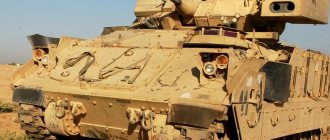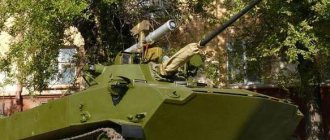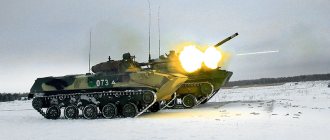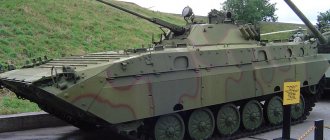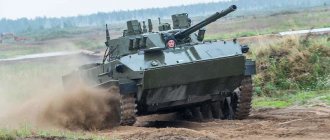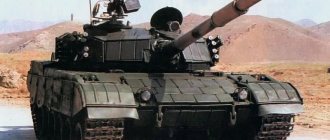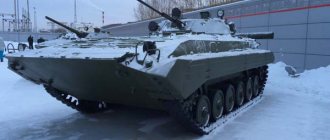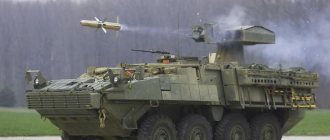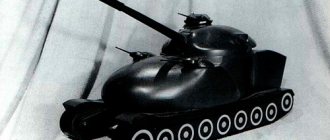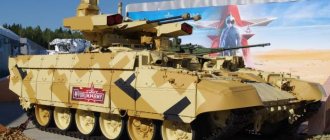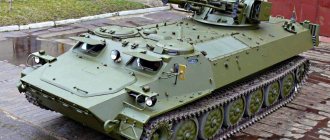BMD-1 Engine. Weight. Dimensions. Armament
BMD-1 (Airborne Combat Vehicle) was created specifically for use in the airborne forces. It was put into service in 1969 and could be dropped by parachute or landing from An-12 type aircraft. The layout of the vehicle was designed taking into account more efficient placement of shooters in it. The hull can be divided into three parts: the control compartment, the central one and the engine-transmission compartment, located in the stern. Above the MTO, the fender niches form a tunnel leading to the aft hatch.
History of creation
The founder of the creation of the BMD-1 was General V.F. Margelov. In 1964, an assignment describing the necessary characteristics of new equipment was issued to the design bureaus of several machine-building plants of the USSR.
According to its characteristics, the machine must:
- protect the crew from small arms fire and grenade fragments;
- swim;
- be capable of air transportation.
During the commission’s consideration, the project of the Volgograd Tractor Plant called “object 915” was recognized as the best. And in 1965, the design bureau team began to implement it. Less than a year later, the first BMD-1 samples were presented for testing. After a series of modifications in 1969, the equipment entered service with the Airborne Forces.
BMD-1 - video
An armored aluminum alloy was used to weld the hull; the turret was made of steel armor. The frontal plates were able to withstand the impact of 12.7 mm bullets. There was a narrowing in the nose, and therefore its cross-section was T-shaped with developed fender niches. The vehicle was equipped with a collective protection system against weapons of mass destruction, consisting of a durable and sealed hull and turret structure, a GO-27 radiation and chemical reconnaissance device, a filter ventilation unit, an engine stopping mechanism and an exhaust ventilation system. In addition, fire-fighting equipment was installed on the BMD-1, including an automatic fire protection installation with a system of temperature sensors located in the MTO, and an OU-2 manual fire extinguisher.
BMD-1 fires from a PKT machine gun
Device
The BMD-1 is equipped with a V-shaped six-cylinder four-stroke diesel engine 5D-20 liquid cooled. The air supply system is distinguished by an air intake device, which includes two kinematically connected valves, which alternately block the air intake from outside the BMD-1 and from the fighting compartment. This measure significantly increases traffic safety afloat. In addition, in the cold season, the air intake from the engine is heated. The ejection cooling system ensures dust extraction from the air cleaner and ventilation of the MTO. There is also an automatic mechanism for protecting the engine from water ingress, which prevents liquid from entering the diesel cylinders when it stops while overcoming a water barrier or washing.
The chassis includes a mechanical transmission consisting of a single-disc dry friction clutch, a simple gearbox (4 forward and 1 reverse), as well as 5 road wheels and 4 support rollers on each side. The individual hydropneumatic suspension consists of 10 air springs. The drive wheels are located at the rear, and the guides are located at the front. The steel fine-link tracks are tensioned using a crank tension mechanism with an electro-hydraulic drive. The movement of the machine through the water is carried out using a water-jet propulsion unit, which consists of two water jets with dampers. Water is pumped out using two pumps with electric motors.
The main armament of the BMD-1 is the same as that of the BMP-1 - a 73-mm 2A28 smoothbore gun with concentrically located recoil devices, located in a single welded rotating turret. The gun's ammunition load consists of 40 rounds placed on a rotating conveyor and supplied to the loading line via an electric drive. In this case, electric and manual guidance drives are used. A 7.62-mm PKT machine gun is paired with the cannon. The machine-gun ammunition capacity is 4,000 rounds. A launch bracket for the 9M14M “Malyutka” ATGM is mounted on the turret, which is controlled from inside the vehicle.
The BMD-1 is equipped with a 1PN22M1 combined sight, six TNPO-170 periscope devices, two TNPP-220 heated periscope observation devices, a TVNE-4 periscope binocular wireless device, and an MK-4S periscope device. The vehicle is also equipped with a radio station R-123 and a TPU R-124 for five subscribers. Based on the BMD-1, the BTR-D amphibious armored personnel carrier has been developed, which is transported by parachute and parachute-jet methods and is intended for transporting personnel, in particular the wounded, as well as weapons, ammunition, fuels and lubricants, etc.
Operators[edit]
Map of BMD-1 operators in blue with former operators in red
BMD-1 of the 103rd Mobile Brigade, Belarus
Current operators[edit]
- Angola - [11]
- Armenia - 10 [11]
- Azerbaijan - 41 [11]
- Belarus - 124 in 1995, 154 in 2000, 2003 and 2005. [11] [28]
- Iran - 200 in service as of 1998.
- India
- Moldova - 44 BMD-1, 9 BTR-D, and 9 2S9. [eleven]
- Russia - About 105 in active service and more than 2400 in storage. [1] [11]
- Ukraine - 61 in 1995, 2000 and 2005. [11] [29]
- Uzbekistan - 110 in 1995, 120 in 2000 and 2005. [11] [30]
Former operators[edit]
- Cuba - left to Angolan troops free of charge. [ citation needed
] - Iraq - 10 ordered in 1980 and delivered in 1981. [31] All destroyed or scrapped.
- Soviet Union - Transferred to successor states.
Performance characteristics of BMD-1
Crew, people: 2 Troops, people: 5 Years of production: 1968—1987 Number of production, pieces: about 3800 Layout: combined combat, landing and control compartment in the front, engine-transmission compartment in the rear
Weight of BMD-1
— 7.2 tons
Dimensions of BMD-1
— Body length, mm: 5400 — Body width, mm: 2630 — Height, mm: 1620—1970 — Base, mm: 2800 — Track, mm: 2380 — Ground clearance, mm: 100—450
BMD-1 armor
— Armor type: rolled aluminum ABT-101 — Hull forehead (top), mm/deg.: 15/75° — Hull forehead (middle), mm/deg.: 32/47° — Hull forehead (bottom), mm/ deg.: 10 / 70° — Hull side (top), mm/deg.: 23 / 0° — Hull side (bottom), mm/deg.: 20 / 0° — Hull stern (top), mm/deg. : 15 / 38° - Hull rear (bottom), mm/deg.: 20 / 9° - Bottom, mm: 12 - Hull roof, mm: 10-12 - Turret front, mm/deg.: 22 / 42° - Tower side, mm/deg.: 18 / 33° - Tower stern, mm/deg.: 12 / 21° - Tower roof, mm: 5
Armament BMD-1
— Caliber and brand of gun: 73-mm 2A28 “Thunder” — Type of gun: smooth-bore semi-automatic grenade launcher — Barrel length, calibers: 29 — Gun ammunition: 40 — Sights: TNPP-220, periscope day and night passive 1PN22M1 — Machine guns: 3 × 7.62 mm PKT - Other weapons: 3 × 9M14M ATGM
Engine BMD-1
— Engine type: 5D20 — Engine power, l. p.: 240
Speed BMD-1
— Highway speed, km/h: 61 — Cross-country speed, km/h: 45–50, (9–10 afloat)
— Cruising range on the highway, km: 500 — Cruising range over rough terrain, km: 400, (96–116 afloat) — Specific power, l. s./t: 32.5 — Suspension type: individual hydropneumatic, with variable ground clearance — Climbability, degrees: 32° — Climbable wall, m: 0.7 — Crossable ditch, m: 2.5 — Crossable ford, m : floats
Content
- 1 Development
- 2 Description 2.1 Overview
- 2.2 Crew
- 2.3 Tower
- 2.4 Armament
- 2.5 Mobility 2.5.1 Maneuverability
- 2.5.2 Amphibious
- 2.5.3 Airdrop methods
- 3.1 Ogaden War
- 4.1 Former USSR
- 5.1 Current operators
What weapons does the vehicle carry?
The turret has a 30mm 2A42 automatic cannon. It can fire both single shots and two automatic ones. The rate of fire ranges from 200-300 rounds per minute, or from 550 in sixty seconds - it all depends on the selected mode. Reloading is carried out manually or using PPL squibs. In addition, there is also a 2E36 weapons stabilizer. Actually, it was developed for the BMP-2 infantry fighting vehicle. But thanks to its attractive properties, it was also adapted for the BMD-2. For aiming at the target, combined sights BPK-1-42 and BPK-2-42 are used. There is also a PZU-8 day anti-aircraft device. In addition to them, manual guidance drives are also provided.
Notes[edit]
- ^ B s d e g h i J k l m p o r QR sec WARFARE.RU . warfare.ru. Retrieved September 20, 2011.
- ^ B s d e g h i J k l m p o r QR sect of global security. Global security. Retrieved September 20, 2011.
- ^ abcdefghijklmnopqrst fas.org. fas.org. Retrieved September 20, 2011.
- ^ abcdef Maxim Saenko. "Armor" of the winged infantry "" ( Armor of the "Winged Infantry"
). Equipment and Armament No. 08/2006, p. 28-32 s. - ^ abcdefghijkl Pancerni.net 1 Archived February 2, 2009, at the Wayback Machine. Pancerni.abajt.pl. Retrieved September 20, 2011.
- ^ a b Global safety of BMD-2. Globalsecurity.org. Retrieved September 20, 2011.
- ^ a b BMD-2. fas.org. Retrieved September 20, 2011.
- ^ abc Maxim Saenko. “Armor” of winged infantry “” ( Armor of “Winged Infantry”
). Equipment and Armament No. 09/2006, p. 29-36 pp. - ^ abcd Pancerni.net BMD-2 1 Archived February 2, 2009 at the Wayback Machine. Pancerni.abajt.pl. Retrieved September 20, 2011.
- ^ abcdef Pancerni.net 2 Archived February 2, 2009, at the Wayback Machine. Pancerni.abajt.pl. Retrieved September 20, 2011.
- ^ abcdefghijklmno A Quick Guide to Russian Armored Combat Vehicles
- "Archive copy" (PDF). Archived from the original on November 3, 2006. Retrieved November 3, 2006 .CS1 maint: archived copy as title (link) CS1 maint: bot: original URL status unknown (link). Retrieved September 20, 2011.
- Pancerni.net BMD-2 2 archived February 2, 2009 at the Wayback Machine. Pancerni.abajt.pl. Retrieved September 20, 2011.
- "Retro Rocket Parachutes" is a short clip showing retro rockets used to slow the fall of large loads on YouTube.
- Testing the PRSM-925 parachute with a retro rosette on YouTube
- "The Path to Airborne Combat Vehicles". Weapons and equipment
(December 2012): 10. Retrieved October 11, 2015. - "Research Institute of Steel Aluminum Armor Information Bulletin". Research Institute of Steel
. Archived from the original on January 7, 2016. Retrieved October 11, 2015. - "Major Milestones". Research Institute of Steel
. Retrieved October 11, 2015. - Grange, David (2002). Air-Mech-Strike, 2nd ed. Paducah, KY: Turner Publishing Co., pp. 86–88. ISBN 9781563116162.
- Debye, Yves (2003). Operation Iraqi Freedom: Victory in Baghdad
. Special Obs 27. Concord Publication. paragraph 48. ISBN 962-361-067-X. - ↑
Lavrov, Anton (2010). The Guns of August: A Chronology of Events (PDF). Moscow: Center for Analysis of Strategies and Technologies. pp. 70–73. - Anatoly Tsyganok, “Assessment of the campaign in the South Caucasus,” Independent Military Review, September 19, 2008.
- ↑
MacDonald, MacDonald (20 March 2014). "Ukrainian troops dig in near Russian border". Chicago Tribune. Reuters. Retrieved December 1, 2014. - Strelkov: The “militia” are driving out the Ukrainian military, since they have decided to give up their equipment. Ukrinform, April 26, 2014
- ^ B s d e e VDV. Warfare.ru. Retrieved September 20, 2011.
- North Caucasus Military District. Warfare.ru. Retrieved September 20, 2011.
- General base . Warfare.ru. Retrieved September 20, 2011.
- Belarusian army equipment. Globalsecurity.org. Retrieved September 20, 2011.
- Equipment of the Ground Forces - Ukraine. Globalsecurity.org. Retrieved September 20, 2011.
- Equipment of the Uzbek army. Globalsecurity.org. Retrieved September 20, 2011.
- SIPRI Arms Transfer Database. armstrade.sipri.org. Retrieved September 20, 2011.
Description of design
The first vehicles began testing in 1984. They were completed successfully and already in 1985 the BMD-2 was put into service. This technique has a welded body. It is made of aluminum armor alloy. This protection makes it possible to ensure the safety of the crew from armor-piercing bullets of 12.7 mm caliber in the frontal projection. This allows you to provide reliable cover from attacks by infantry. The all-round protection is only designed to stop 7.62. The BMD-2 device allows you to increase the crew to 3 people (there is a job for everyone). True, in such cases it is necessary to reduce the number of troops to 4 soldiers. There are three TNPO-170A surveillance devices. They are installed above the driver in front of the hatch. On the outside of the armored vehicle there are headlights, side lights, a sound signal, a wave-reflecting shield, rear and front mud flaps, a radio antenna, jet shutters, tow hooks, mounting parts for landing, a device for transporting cargo using a trailer, as well as two boxes with spare parts , tools and accessories. And little things - a packing device, a shovel, a tarpaulin, a crowbar and an emergency buoy. To maintain communication, a radio station R-173 is provided. It provides the ability to negotiate at a distance of up to 20 kilometers. The whip antenna can reach three meters. To receive signals, radio receivers R-173P and TPU R-174 are usually installed. Although the very first representatives were equipped with R-123M and TPUR-124 devices. The latest vehicles were produced with R-163-50PU radio stations, not R-173. This option made it possible to maintain a stable exchange of digital and analog information in the frequency range from 30 to 80 MHz and at a distance of up to twenty kilometers. At the same time, the possibility of automated transition to the backup frequency was implemented.
